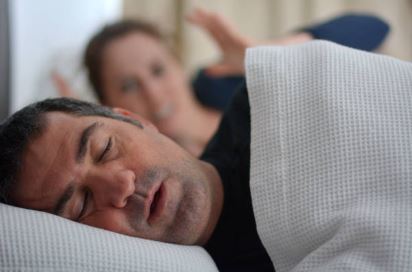Sleep Apnoea or Obstructive sleep apnea (OSA)
Sleep apnoea can occur at any age and doesn’t just affect overweight people. But being overweight carries a high risk factor for the development of sleep apnoea. This is when breathing repeatedly stops for several seconds during sleep. It is seen in many overweight and obese people as result of additional soft fatty tissue around the face and neck – as airways can become blocked and breathing restricted. This then leads to a reduction in oxygen in the blood a serious issue.
Signs of sleep apnoea:
- Snoring
- Waking up tired (not refreshed)
- Day-time sleepiness
- Altered mood (often grumpy)
- Morning headaches
- Difficulty concentrating
- Memory loss
The best way to test for sleep apnoea is to have someone (ideally a partner/spouse) let you know what your sleep habits are like – loud snoring is often the first sign.

When in a deep sleep the muscles of the throat often relax, which is not usually a problem. However, in sleep apnoea the muscles at the back of the throat become so relaxed during sleep that the airway or part of it becomes closed off. A person with sleep apnoea will continue to try to breathe – but no air will enter the lungs and the level of oxygen in the blood drops (hypoxia). This eventually leads to semi-wakening and breathing resumes, usually accompanied by a loud snort or gasp.
The person affected is often unaware that they have woken and immediately returns to sleep. Once asleep the muscles relax again and the whole cycle recurs. This cycle can occur hundreds of times during sleep which, like insomnia, reduces the quality and benefits of a good night’s sleep. Loud, bothersome snoring will also occur.
The risk of sleep apnoea is higher if a person is overweight. Excess weight on the outside of the throat increases pressure on the inside of the throat, which in turn narrows the airway. Ormiston Weight Loss Services sees many patients who suffer from sleep apnoea but are cured following weight loss after surgery.
Other risk factors include:
- Alcohol, tranquillisers or sleeping tablets are being used
- An existing condition that may block the airway eg: enlarged tonsils or jaw deformities
- Nasal obstruction
There are a number of signs and symptoms that may indicate that OSA is occurring. Often, the first indication is complaints about noisy snoring.
How do I know if I or someone I love has sleep apnoea?
As there can be many reasons for disturbed sleep or daytime sleepiness diagnoses can be difficult. If sleep apnoea is suspected, referral to a respiratory physician and/or an otolaryngologist (ear, nose and throat specialist) may be required.
A doctor will first take a detailed history of the problem and will examine the throat for signs of narrowing. It may often be helpful for a support person to be there at this appointment to explain what happens with the sufferers sleep cycles.
Tests may be used to confirm the diagnosis.
How is it treated?
OSA needs to be managed firstly through lifestyle changes, often in combination with other treatments. The biggest change is in weight loss, even a small amount can improve symptoms. Ormiston Weight Loss Service regularly sees overweight patients who complain of sleep apnoea and have their symptoms disappear following surgery and weight loss.
There are other measures that can be taken such as; avoiding alcohol, sleeping tablets, changing sleeping behaviours, quitting smoking and performing regular exercise.
If you or someone you know is overweight and struggling with sleep weight loss surgery could help their condition and help them get back to getting a full nights sleep. Sleep apnoea is a serious condition and can lead to further health problems such as hypertention, heart disease, stroke, and arrhythmia (irregular heart beat). Sufferer must speak to their GP about their concerns.
